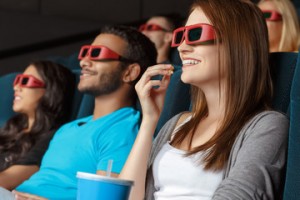Has 3D Entertainment got you Wondering?
 3D entertainment has historically been a treat for kids of all ages. You may have to attend a screening of a 3D movie during your childhood, feeling oh so special with that plastic, blue and red glasses over your eyes. Maybe you passed down the magic of the modern-day 3D movie by taking your family to such a flick. As an adult, you may have noticed that your eyes didn’t quite adjust as you imagined they would to what you saw on the big screen.
3D entertainment has historically been a treat for kids of all ages. You may have to attend a screening of a 3D movie during your childhood, feeling oh so special with that plastic, blue and red glasses over your eyes. Maybe you passed down the magic of the modern-day 3D movie by taking your family to such a flick. As an adult, you may have noticed that your eyes didn’t quite adjust as you imagined they would to what you saw on the big screen.
Thankfully, 3D is not the norm for our viewing pleasure – at least not yet! This could feel like an unpleasant advancement to anyone who is sent into slight dizziness or nausea by the advanced technology of this type of imaging. If you have had this type of experience with 3D, fret not; your eyesight is not the problem, at least not in a way that requires treatment.
Imitation is the Greatest form of Flattery
The eyes are naturally designed to create a 3-dimensional view of the world. This happens in the simplest manner, the spacing of the eyes. Because the eyes are situated about 2 inches from one another, each offers you a particular view. Try it out! Look in front of you through only one eye, and then the other. When both of your eyes are open and working together, the two views blend. More precisely, they overlap ever so slightly. When films are made in 3D, this is what is recreated; the natural function of the eye.
How it Works
The 3D film is created in the same manner as your everyday view, through two perspectives. This is accomplished with two separate cameras that are situated in the fashion of the natural eye, a few inches apart. Using this technique, the filmmaker is able to recreate the overlap of the natural eye. The thing is, you cannot observe this overlap with the natural eye. To do so creates a sort of double-vision, not to mention the motion-sick feeling that goes with it.
Where it may go Wrong
The whole point of 3D glasses is to filter light so what is on the screen can jump out to the eye (and the brain). However, some people’s binocular vision gets in the way of their 3D view. Slight inconsistencies with binocular vision, or how the eyes work in unison, typically don’t create visual disturbance in the “real world,” but they do in the 3D world.
Your ability to enjoy 3D entertainment, fortunately, has very little impact on your life in general. Understanding how the eyes work, you now know why you may want to just skip such films.
3D entertainment has historically been a treat for kids of all ages. You may have to attend a screening of a 3D movie during your childhood, feeling oh so special with that plastic, blue and red glasses over your eyes. Maybe you passed down the magic of the modern-day 3D movie by taking your family to such a flick. As an adult, you may have noticed that your eyes didn’t quite adjust as you imagined they would to what you saw on the big screen.
Thankfully, 3D is not the norm for our viewing pleasure – at least not yet! This could feel like an unpleasant advancement to anyone who is sent into slight dizziness or nausea by the advanced technology of this type of imaging. If you have had this type of experience with 3D, fret not; your eyesight is not the problem, at least not in a way that requires treatment.
Imitation is the Greatest form of Flattery
The eyes are naturally designed to create a 3-dimensional view of the world. This happens in the simplest manner, the spacing of the eyes. Because the eyes are situated about 2 inches from one another, each offers you a particular view. Try it out! Look in front of you through only one eye, and then the other. When both of your eyes are open and working together, the two views blend. More precisely, they overlap ever so slightly. When films are made in 3D, this is what is recreated; the natural function of the eye.
How it Works
The 3D film is created in the same manner as your everyday view, through two perspectives. This is accomplished with two separate cameras that are situated in the fashion of the natural eye, a few inches apart. Using this technique, the filmmaker is able to recreate the overlap of the natural eye. The thing is, you cannot observe this overlap with the natural eye. To do so creates a sort of double-vision, not to mention the motion-sick feeling that goes with it.
Where it may go Wrong
The whole point of 3D glasses is to filter light so what is on the screen can jump out to the eye (and the brain). However, some people’s binocular vision gets in the way of their 3D view. Slight inconsistencies with binocular vision, or how the eyes work in unison, typically don’t create visual disturbance in the “real world,” but they do in the 3D world.
Your ability to enjoy 3D entertainment fortunately has very little impact on your life in general. Understanding how the eyes work, you now know why you may want to just skip such films.
Category:





